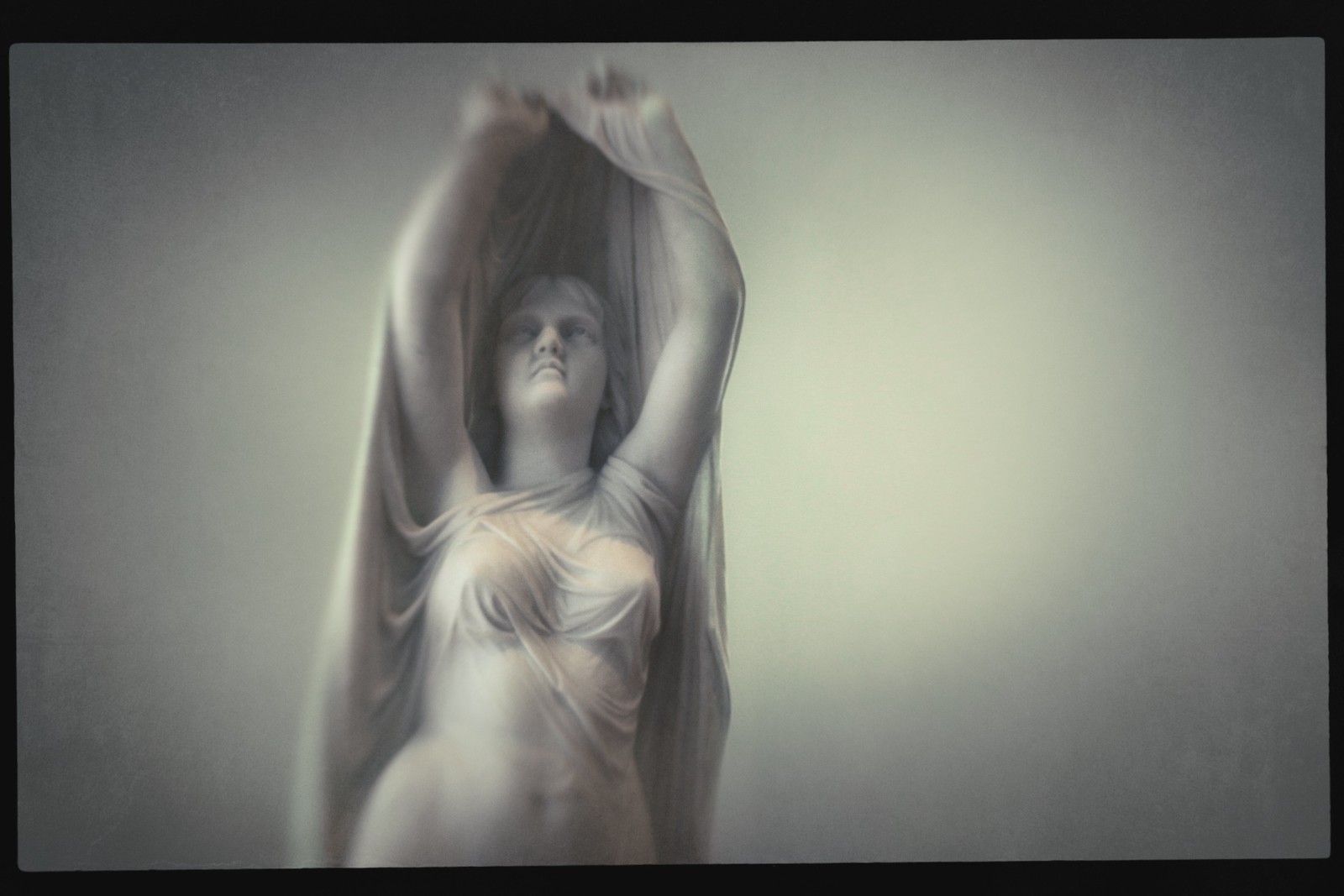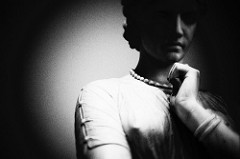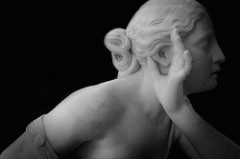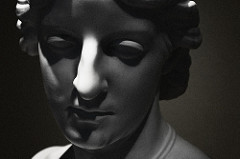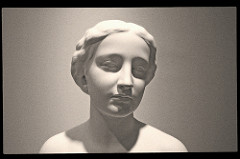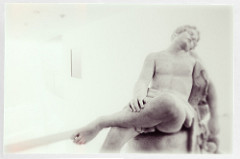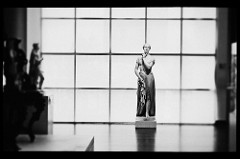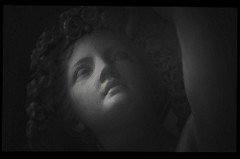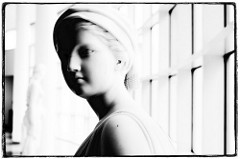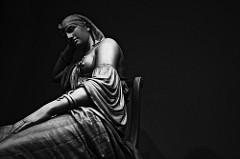Portrait of Chauncey Bradley Ives' "Undine Rising from the Waters". 1859. Marble. High Museum of Art. September 2015.
undine
The High Museum writes of the 1859 sculpture, "Rooted in medieval legend, the story of Undine—a mortal but soulless sea spirit—gained prominence in the 1800s through historical fiction and opera. Chauncey Ives depicts the tale’s dramatic climax: Undine rises from the water to take revenge on her unfaithful husband. Unlike other artists, Ives chose to represent the heroine as victimized rather than vengeful. Such emotional restraint was in keeping with the work’s sober Neoclassicism and greatly appealed to a Victorian sensibility."
Let's examine the trends and sentiments that made Undine popular and see if we can formulate a clearer picture on the predicament of the character Ives chose to sculpt, and what might have made her appealing for that time.
Yale University relates the book that popularized the undine as being Friedrich Heinrich Karl de la Motte Fouqué’s 1811 Undine. Fouqué also is known for being the first to pull together a modern German dramatization of the Nibelung legend, combining various sources, which had an influence on Wagner's "Der Ring des Nibelungen".
Edgar Allan Poe wrote an adoring review of the Undine for Burton's Gentleman's Magazine.
...the hand of the master is visible in every line of his beautiful fable. “Undine” is a model of models, in regard to the high artistical talent which it evinces. We could write volumes in a detailed commentary upon its various beauties in this respect. Its unity is absolute — its keeping unbroken. Yet every minute point of the picture fills and satisfies the eye. Every thing is attended to, and nothing is out of time or out of place.
Neither story nor style are to my taste. I find everything out of time and out of place, and this isn't a matter of a "generations gap".
These are the fundamentals of the story.
A fisherwoman takes her three-year-old daughter to the water to play. The daughter falls out of her arms into the water and is lost. That night, another beautiful child of the same age is left at the doorstep of the fisherman and his wife, and they keep her. As this is a fairy tale we needn't question why the couple doesn't attempt to find the child's parents and instead simply accept her sudden appearance. The impression is even given that in fairy tale logic the child is uncomfortably received as having been sent as a substitute and so one might not want to examine her strangeness too closely and learn the truth of her, for Undine (who is a little like a changeling) is a hellion in that she runs wild and doesn't care too much about the feelings of others. Her foster parents seem well aware of her peculiar affinity with water.
In the meanwhile, the daughter of the couple, the one who had fallen into the water, has been given, by Undine's water spirit uncle, to a duke and duchess. In their castle, she grows up to be the beautiful but haughty Bertalda. Many profess their love for her, including a knight by the name of Huldbrand. For no real reason, she sends him out on an adventure in the woods. By way of bothersome, frightening encounters, he comes upon the home of Undine and is given refuge by her foster parents. He tells Undine the story of Bertalda, of whom he says he was already growing weary because of her attitude. Undine falls in love with the knight and they marry, whereupon he discovers from Undine her true story which she has never divulged to her foster parents, that she is the daughter of water nobility, and her father was determined she should have a human soul, which could only be obtained by the sufferings of affection. Now, on her wedding night, united with Huldbrand, she has fallen in love and possesses a soul.
When Undine does gain her soul, it's evident that she now possesses one because that's when she starts dusting and cleaning. Yes, she starts helping around the house, nudged on by now caring for others, which means she has empathy and empathy is good, but the emphasis on her throwing herself into dusting and cleaning stands out oddly. The message is that if you are a woman and you don't dust and clean then you are incomplete as a female, and it's rather a clumsy footnote of a message, as if the author felt he must inject what isn't an essential component to the fairy tale.
Though, after acquiring a soul, Undine is unfailingly faithful, sweet, and loving, Huldbrand finds himself wrestling with whether he loves her or not as she is different and her water family can be annoying and frightening. If you're at all familiar with the 1960s sitcom, Bewitched, it's a little like that. Darren is continually annoyed with Samantha for being unable to completely deny her past and her nature and become something other than what she is.
They return to the castle and Undine insists upon keeping Bertalda around as their best friend, so we know doom is in store for them. Repulsed by Undine's true nature, that she isn't human, the knight is drawn to Bertalda. When Bertalda's true parentage is eventually revealed, she rejects the fisherman and fisherwoman as commoners, and when the duke and duchess then reject her for being heartlessly materialist and elitest, Undine insists upon taking her in. To get away from things, they decide to go to Vienna on vacation, and while on the boat Bertalda drops her necklace in the water. Undine has repeatedly told Huldbrand that if he chastises her around water she will be taken away from him, but this time, when Undine magically raises from the water an even more beautiful necklace for Bertalda, he's had too much of her witchy ways and tells her to return to her people and leave them in peace. Undine disappears and Huldbrand decides to think of himself as a widower.
Bertalda and Huldbrand fall in love and are to be married. By law of nature, Undine must kill Huldbrand if he marries again, but the fountain by which she might have returned she'd had capped and is glad to not be able to return and kill him. Bertalda, however, has the fountain uncapped, believing its water will make her more beautiful on her wedding day. Undine had attempted to warn Huldbrand in a dream not to marry, that she was still alive, but he does so anyway, and Undine returns via the fountain, as she must. Seeing her again, our indecisive knight realizes it's her he has always loved. She embraces him and he dies with her "holy" kiss, she weeping him to death. Then, reunited with Huldbrand again, Undine's waters surround his burial place, presumably to the end of time.
What's the point of the story, I really don't know. Bertalda is obviously a complement to Undine, they are bound together in this story, one a mortal who naturally possesses an immortal soul but doesn't love, and one an elemental who has gained an immortal soul through love. The faithful water witch is the best "person" of the three, aware of the preciousness of her soul, and is doomed to not be able to maintain a relationship with a mortal as we are fickle. However--and it's a big caveat--in the case of human relations, dissolving a marriage and marrying another doesn't mean you will die, while in the case of loving an Undine, you must. Huldbrand drowns, essentially, in her loving, mournful tears.
Pagan nature is ruthless in the story, uncaring of human frailty and emotions, despite Undine's father desiring her to have a soul, so the message is not that the world of Christian mortals is less desirable. Undine is only as sweet as she is because she acquired a soul, and the knight's decision to marry her is confused. She is willfully intent on having him with a rather devious determination that is a part of her nature, he is mystified by her ways and somewhat drawn to her because she is different, and seems to settle on marrying her in order to save her and try to change her. And she does change, becoming almost the perfect woman, but she loses him in the process and only fully possesses Huldbrand again through her mourning their love and his death as she kills him.
Status is a major part of the story and isn't metaphorical. Bertalda may be reproved for disdaining her lower birth, but that lower birth is obviously not desirable or else Undine would not be herself a princess who is assigned to live as a commoner until she gets the love of the knight who is guided to her, who has been sent into the forest by Bertalda. Having acquired this love, Undine leaves the humble abode of her foster parents and enters again elite society, which she never really left, for being of royal birth meant she was always patrician. Bertalda, on the other hand, is of common birth. Others of common birth behave well in the story, and by this I mean not exhibiting class envy, but Bertalda was one that was removed from her natural place and brought up among royalty. This is Bertalda's failing. Though she did not remove herself from the home of her natural parents as a child, she has transgressed the natural order. What is their doom is that after learning of her common birth Bertalda's skin begins to freckle, betraying her lower origins. She has lost her pristine "fairness", and she demands the stone be removed from the castle fountain as she believes it was the waters of the castle fountain that had previously kept her skin clear, and that these waters (coincident with her marriage to royalty) will restore her fairness.
Baron Fouqué was an aristocrat, so is it any wonder. A reason his works, which were at one time so popular in Europe, later fell out of favor, was due a European backlash against "aristocratic pretention", which didn't happen in America.
Eventually, I found that Undine was based on an Elisabeth von Breitenbach, and then I had to search all over to find who this woman was, finally locating her brief story in a German paper. Before I give the relevant quote, I want to note that the character of Undine greatly puzzled me at the book's beginning, when she did not yet have a soul, for though she was supposed to be eighteen she behaved as if she was a child.
This is the rough Google translation:
Edgar Allen Poe, for example, pointed out in 1839 that the figure of the "Undine" has striking features of the then 15-year-old Elisabeth von Breitenbach, whom Fouqué met in April 1795. He describes this in his autobiography as a "tender, just recently blossoming virgin of noble tribe ..." and is seen by many literary scholars as a role model for literary Undine.
Poe, who married his cousin when she was only thirteen, is frequently given as greatly influenced by Undine, and believed the work to be autobiographical, revealing that Fouqué had marriage problems.
Poe wrote, in his review of the book:
In the contrast between the artless, thoughtless, and careless character of Undine before possessing a soul, and her serious, enwrapped, and anxious, yet happy condition after possessing it — a condition which, with all its multiform cares and disquietudes, she still feels to be preferable to her original fate — M. Fouqué has beautifully painted the difference between the heart unused to love, and the heart which has received its inspiration.
The jealousies which follow the marriage, arising from the conduct of Bertalda, are the natural troubles of love — but the persecutions of Kuhleborn and the other water-spirits, who take umbrage at Huldbrand’s treatment of his wife, are meant to picture certain difficulties from the interference of relations in conjugal matters — difficulties which the author has himself experienced. The warning of Undine to Huldbrand — “reproach me not upon the waters, or we part for ever” — is meant to embody the truth that quarrels between man and wife, are seldom or never irremediable unless when taking place in the presence of third parties. The second wedding of the knight, with his gradual forgetfulness of Undine and Undine’s intense grief beneath the waters — are dwelt upon so pathetically and so passionately — that there can be no doubt of the personal opinions of the author on the subject of such marriages no doubt of his deep personal interest in the question.
How thrillingly are these few and simple words made to convey his belief that the mere death of a beloved wife does not imply a final separation so complete as to justify an union with another — “The fisherman had loved Undine with exceeding tenderness, and it was a doubtful conclusion to his mind, that the mere disappearance of his beloved child could be properly viewed as her death!” This is where the old man is endeavoring to dissuade the knight from wedding Bertalda.
...
That M. Fouqué was well aware of the disadvantage under which he labored — that he well knew the field he traversed not to be the fairest — and that a personal object alone induced him to choose it — we cannot and shall not doubt. For the hand of the master is visible in every line of his beautiful fable. “Undine” is a model of models, in regard to the high artistical talent which it evinces. We could write volumes in a detailed commentary upon its various beauties in this respect.
Poe ends with declaring Undine the Knight's spiritual wife.
Poe, born in 1809, is referring then to his personal experience with Virginia, who he'd married in 1835 and so in 1839 would have been 17.
Fouqué, born in 1777, was married three times. If he met Elisabeth in 1795 he was only about 18. In 1798, when he was 21, he married 14-year-old Marianne von Schaubaert, the daughter of his regimental commander. This marriage was said to be unhappy, produced no children and ended in three years. He next married in 1803 Caroline von Briest who was born in 1773, the ex-wife of Adolf Ludwig Rochus von Rochow. They had a number of children. After she died in 1831 he married in 1833 Albertine Maria Tode born 1806.
I don't know what Poe's interpretation of Fouqué's situation was but we find ourselves, it seems, confronted with another idealized vision of femininity that is probably not 18 but a girl of about 14 or 15, and I have to wonder if the death of the Knight would be interpreted by Poe as Huldbrand's inability to love another after having possessed an Undine. His review shows that he is convinced that Undine, modeled upon a 15-year-old met in 1795, is the vital inspiration. But it is anyone's guess and many have tried to guess. Some think that the two faces of of Undine were instead inspired by his second wife, Caroline, who had an affair in her first marriage. Another believes that Poe saw in Undine Fouqué's first marriage to Marie mourned even as he married his second wife.
Considering Poe's problematic marriage (and it was problematic, on the marriage certificate he gave Virginia as twenty-one), it may be that in Huldbrand's love for Undine he recognized or believed he recognized an illicit love similar to his own. Undine's uncle is a menace to Undine's marriage throughout, raising the elements against Huldbrand when he mistreats Undine, and ultimately Undine is taken from Huldbrand. Poe similarly complains of interference in his marriage. But the most resonant feature, I would believe, is that Poe's Virginia was thirteen when they married, and Undine is based upon a girl of fifteen. On top of which, Fouqué's first wife was fourteen when they married.
But back to the aristocratic Fouqué, who was a romantic nationalist, and whose work would influence Wagner, as well as Tolkien's Lord of the Rings. He and others in his sphere were interested in defining legitimate culture, which meant patrician and nationalist. When satirized by the Jewish writer and critic M. G. Saphir, they angrily responded that his humor "can never triumph in the minds of the well-informed. His only goal has been to impress the mob..." As Jefferson Chase's Inciting Laughter: The Development of "Jewish Humor" in 19th Century German Culture points out, these arguments posed by Fouqué and his Königstädter Theater clique were decidedly political. "The word mob...invoked the image of a vandalous rabble and, with it the specter of the Reign of Terror. Likewise, in 'M. G. Saphir and Berlin', Fouqué and his co-authors borrowed a phrase from Goethe and accused their enemy of being a literary sans-culotte, hinting ominously that the impulses underlying his brand of humor were those of political anarchy. The pseudo-patricianism of this attitude and its accompanying vocabulary should come as no surprise. The nightmare vision of the unthinking masses whipped up into murderous frenzy had also been conjured up by Friedrich Wilhelm's ministers, who of course did not distinguish between the government's rule and the public welfare.."
The attack against Saphir as an outsider (ironically Fouqué's Prussianized family entered Germany as French Huguenots) was not openly anti-Semitic but it could be read between the lines.
This loathsome presence will come to an end. That much is certain... Yet how will later historical portraits describe the Berlin of this period? What does the well-informed foreigner think about the capital of intellectually cultivated Germany? The Viennese is already grinning at us...
As Inciting Laughter... states, these arguments against Saphir "more importantly...served to formulate a common patriotic agenda for his enemies. In other words, branding Saphir a traitor was perhaps less a strategy of attack then a mechanism of self-definition. This rhetorical tendency pointed up the growing importance of national categories in the Königstädter clique's sense of shared purpose. More and more it was not just Berlin they claimed to be defending but Germany...the Königstädter clique's tendency (was) to draw parallels between Saphir's humor and his lack of social integration...his adversaries would admonish him for poking fun at his co-religionists--a point of criticism soon to be generalized into the idea of inherent Jewish treachery...this idea was one of the building blocks for a spate of later conspiracy theories about pernicious Jewish influence on German society...radical antisemitism was untypical for most members of the Königstadter clique...yet the stereotype of the Judenwitzler stood readily available for reinterpretations of career rivalries and aesthetic disagreements. This laid the groundwork of the central narrative of German literary history--the belief that the mercenary Jewish writers of the 1820s, 30s and 40s had undermined the cultural achievements of German Classicism."
And though Jefferson Chase states radical antisemitism was "untypical", Saphir wrote that the results of "The Berlin Thirteen and all the other Wednesday poets, whose primary rule in literature is to flatter the higher-ups and whose primary aesthetic maxim runs 'beautiful is whatever the police like'" was only to pathetically scrape together against Saphir, Ludwig Borne and Heinriche Heine (the writers Borne and Heine were also critics and satirists), "'They're all Jews!' They had mustered every last bit of grey matter and native with they had, but they couldn't come up with an argumentative retort any better than this old wives' weapon. Admittedly it is very cheap to produce and still very much a part of German literature's standard arsenal--to it's shame."
This was what I was wondering if we would find, when I read that Wagner drew upon Fouqué for his "Der Ring des Nibelungen", and I could go on and on as there is plenty of material but that's enough.
Sentimentalism of the kind that we frequently find in neo-classism and romanticism is a nostalgic search for identity and ideals (purity, heroism), and if it feels artificial one of the problems is that authenticity and real examination of self and society must be sacrificed out of allegiance to, and for the maintenance of, a false harmony.
The tale of Undine may, at first glance, appear to question certain societal codes, but only ultimately confirms them. Undine isn't a commoner, Bertalda is, and is unfit to be the wife of a knight.
What Poe saw in the love of the Knight for Undine needs to be considered as well, and may be a reason why the story eventually became more and more oriented toward children, Undine's nature, with or without soul, being that of the idealized "wise" child. Undine is the young girl who is closer to nature than civilization, who is modified by the man and their love so that she becomes the female who is utterly incapable of guile, conceit and selfishness. In a male, I would hazard these attributes might be the property of the classic Fool. Traits of utter lack of guile, conceit or selfishness are instead almost always applied to a girl who falls in love with an older man. Movies and books have repeatedly related this very particular equation, that of a man finding his true love in a young girl who is his spiritual soul mate and doesn't desire him for money or status. In such stories, it takes very few years for a girl to move from innocence to the corruption that is equated with an adult woman's nature.
The mournful I-have-no-choice-but-to-kill-you moment is the one Charles Ives captures in his statue, which is praised for the delicacy of its clinging rivulets of drapery. To me, the statue instead has all the delicacy of a wet t-shirt contest--but I do appreciate enough the skill that I tried to bestow on the carving a sense of watery motion, of Undine rising from the depths. The care that Ives put into the wet t-shirt is neglected when one considers the face, Undine being utterly vapid. She is not anguished. Irredeemable fate may motivate her, but regret over her mission doesn't distort her features. She is soulless. We only know she is Undine because we are told she is, and the point of this Undine is only to show off the feminine figure by excuse of Undine rising out of the watery fountain.
The High Museum's page on Undine
The sculpture was a gift of the West Foundation in honor of Gudmund Vigtel, director of the High Museum from 1963 thru 1991, and Michael E. Shapiro, director at the High Museum from 2000 to 2015.
Go to this gallery's index/description
Return to Photography Galleries

